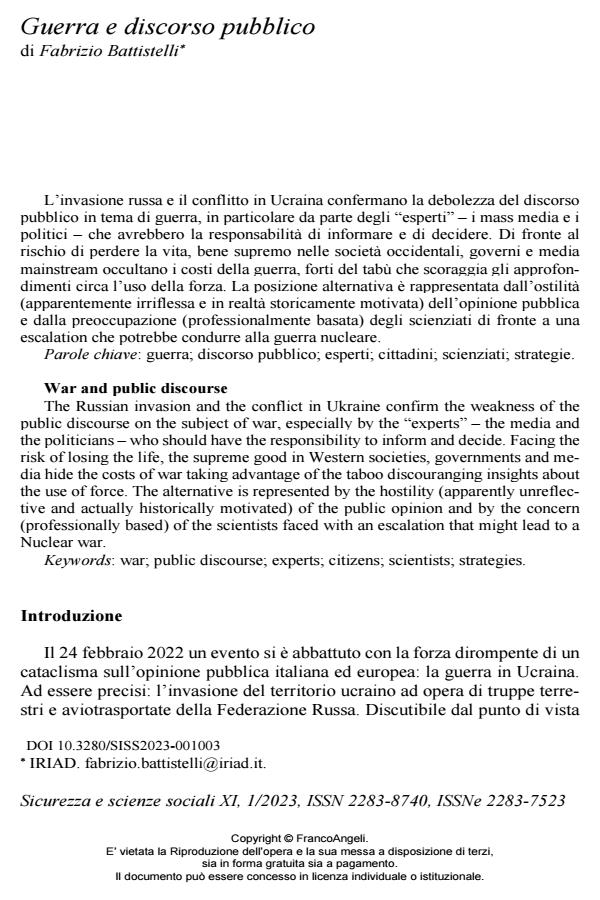War and public discourse
Journal title SICUREZZA E SCIENZE SOCIALI
Author/s Fabrizio Battistelli
Publishing Year 2023 Issue 2023/1
Language Italian Pages 13 P. 15-27 File size 175 KB
DOI 10.3280/SISS2023-001003
DOI is like a bar code for intellectual property: to have more infomation
click here
Below, you can see the article first page
If you want to buy this article in PDF format, you can do it, following the instructions to buy download credits

FrancoAngeli is member of Publishers International Linking Association, Inc (PILA), a not-for-profit association which run the CrossRef service enabling links to and from online scholarly content.
The Russian invasion and the conflict in Ukraine confirm the weakness of the public discourse on the subject of war, especially by the "experts" - the media and the politicians - who should have the responsibility to inform and decide. Facing the risk of losing the life, the supreme good in Western societies, governments and media hide the costs of war taking advantage of the taboo discouranging insights about the use of force. The alternative is represented by the hostility (apparently unreflective and actually historically motivated) of the public opinion and by the concern (professionally based) of the scientists faced with an escalation that might lead to a Nuclear war.
Keywords: war; public discourse; experts; citizens; scientists; strategies.
- Agamben G. (1995). Homo sacer: il potere sovrano e la nuova vita. Torino: Einaudi.
- Arnett P. (1997). Transcript of Osama bin Laden interview by Peter Arnett. Information Clearing, March.
- Battistelli F., Galantino M.G., Lucianetti L., Striuli L. (2012). Opinioni sulla guerra. L’opinione pubblica e l’uso della forza. Milano: Franco Angeli.
- Battistelli F., Galantino M.G. (2019). Dangers, risks and threats: An alternative conceptualization to the catch-all concept of risk. Current Sociology. Vol. 67, n.1: 64-78.
- Baudrillard J. (2002). Lo spirito del terrorismo. Milano: Cortina.
- Bulletin of Atomic Scientist (2023). A time of unprecedented danger: It is 90 seconds to midnight. January, 24. -- https://thebulletin.org/doomsday-clock/current-time.
- Einstein A. (1947). Letter of 22 January 1947. -- https://sgp.fas.org/ eprint/einstein.html.
- Everts Ph., Isernia P. (2001). Public Opinion and the International Use of Force. London: Routledge.
- FAS - Federation of American Scientists (2023). Status of World Nuclear Forces. -- https://fas.org/issues/nuclear-weapons/status-world-nuclear-forces.
- Fornari F. (1975). Psicoanalisi della guerra. Milano: Feltrinelli.
- Foucault M. (1998). I corsi al Collège de France. Milano: Feltrinelli.
- Giacomello G., Coticchia F. (2007). In Harm’s Way: Why and When a Modern Democracy Risks the Lives of Its Uniformed Citizens. European Security. Vol. 16, n. 2: 163-182.
- Gigerenzor G. (2008). Moral Intuition = Fast and Frugal Heuristics?. In: W. Sinnot-Armstong (ed.), Moral Psychology. Vol. 2. The cognitive science of morality: Intuition and diversity. Cambridge, MA: Mit Pren: 1-46.
- Inglehart R. (1983). La rivoluzione silenziosa. Milano: Rizzoli [ed. orig.1979].
- Kagan R.A. (2003). Paradiso e potere: America ed Europa nel nuovo ordine mondiale. Milano: Mondadori.
- Kagan R.A. (2004). Il diritto di fare la guerra. Il potere americano e la crisi di legittimità. Milano: Mondadori.
- Kahn H. (1966). Filosofia della Guerra atomica. Esempi e schemi. Milano: Edizioni del Borghese.
- King A. (2010). The Afghan War and “postmodern” memory: commemoration and the dead of Helmand, The British Journal of Sociology. Vol. 61, n. 1: 1-25.
- Krastev I., Leonard M. (2022). The Crisis of European Security: what European think about the war in Ukraine, European Council on Foreign Relations. https://ecfr.eu>tipe>publication. 9 February 2022.
- Leshem O.A., Halperin E. (2020). Lay theories of peace and their influence on policy preference during violent conflict. PNAS. Vol. 117, n. 31: 18.378-18.384.
- Luttwak E.N. (1994). Where are the great powers? At home with the kids. In: Foreign Affaris. Vol. 73, n. 4: 23-28.
- Mueller J.E. (1970). War, Presidents and Public Opinion. New York: Wiley.
- Ricci A. (2022). Scenari nucleari in Italia. La minaccia nucleare. IRIAD Review. Studi sulla pace e sui conflitti. Settembre: 4-23. -- https://www.archiviodisarmo.it/view/OJfht-iVLsdLWNA4raZPufRlUxGujzLulD7oz-dHWrM/iriad-review-09-22.pdf
- Rusconi G.E. (1987). Rischio 1914. Come si decide una guerra. Bologna: il Mulino.
- Schmitt C. (1972). Le categorie del “politico”: Saggi di teoria politica. Bologna: il Mulino.
- Sipri Yearbook (2022). Armaments, Disarmament and International Security. Oxford: Oxford University Press.
Fabrizio Battistelli, Guerra e discorso pubblico in "SICUREZZA E SCIENZE SOCIALI" 1/2023, pp 15-27, DOI: 10.3280/SISS2023-001003